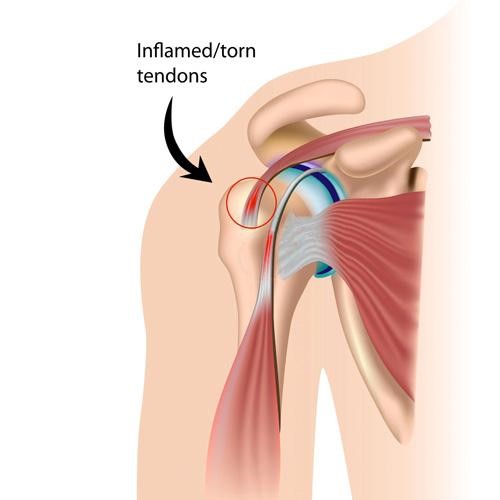The Rotator Cuff describes a group of four muscles that hold your shoulder in its socket while your larger muscles move your arm. Your rotator cuff tendons live in an area of your shoulder called the “subacromial space”. Sometimes this space can become crowded by abnormally shaped bones, arthritis, spurs, or even lazy muscles that cannot keep the bones separated properly. This overcrowding may create a painful pinching of the rotator cuff tendons and/or bursa when you raise your arm. This condition is called “Shoulder Anterior Impingement Syndrome”, or simply “Impingement”. Long-standing impingement leads to rotator cuff tears in much the same way that a rope is damaged by repeatedly being struck by a dull stone.
Impingement is the most common shoulder disorder and accounts for about half of all shoulder complaints seen by physicians. Those who perform repetitive overhead activity are at greater risk for impingement. This includes athletes who take part in swimming, baseball, volleyball, weightlifting, and tennis and professionals such as carpenters, electricians, painters, and wallpaper hangers.
Impingement often starts after a period of overuse. Initially, your symptoms may be limited to sharp pain during overhead activity or while reaching behind the back to fasten a bra or close a zipper. As your condition progresses, you may develop a constant ache that is present even at rest. Nighttime pain is common, often disrupting sleep. Impingement is a disorder that, if left untreated, will progress through 3 stages (described below) and eventually lead to rotator cuff tearing and surgery.
ROTATOR CUFF TEARS
We classify rotator Cuff injuries into one of 3 stages by the amount of damage present: “partial tears”, “full-thickness tears” or “ruptures”. A partial tear means that one side of your tendon has been partially frayed. A full-thickness tear, sometimes called a “complete tear”, describes a hole or slit in your tendon, much like what would be created by running a knife lengthwise down a rope. A rupture is the most serious injury and means that your tendon has been torn into two pieces.
Less than 10% of rotator cuff tears result from an acute injury, such as from falling, pushing, pulling, throwing, or lifting. The vast majority of injuries result from repetitive strains over a long period. One of the most common reasons that patients develop a rotator cuff tear is impingement as described above. Those who perform repeated overhead activities are at the greatest risk for rotator cuff tendon problems similar to shoulder impingement. Other known risk factors for rotator cuff problems include smoking, obesity, high cholesterol, and prior cortisone injection.
Patients who have suffered an acute rotator cuff injury often report a tearing or snapping sensation accompanied by severe pain and weakness. Most chronic repetitive strains begin silently, with symptoms becoming more clear as the tear progresses. Pain is often localized to the front and outside of your shoulder, but can sometimes radiate down your arm. Symptoms are usually aggravated by overhead activity and may progress to where you have difficulty raising your arm overhead. Pain is often worse at night, especially when you lie on the affected shoulder.
Shoulder Anterior Impingement Syndrome responds very well to conservative care and can stop the potential for progression towards a rotator cuff tear. Young patients who have suffered an acute tear or rupture may require surgery, but most impingement patients will benefit from conservative treatments like the type provided in this office.
Credit: Information on this page provided by ChiroUp.

I really love it here! They are very friendly and I feel Dr. Wilson is giving me great treatment! I also don’t feel pressured into coming back too frequently. The adjustments are great! Great office!
Dr. Matthew squeezed me in on short notice and took very good care of me. He was very thorough and didn’t just adjust me and let me walk out. Amazing experience here and the receptionist is a sweetheart.
My family have used chiropractic and physical therapy services here and every one of us have had excellent outcomes. I wouldn’t go anywhere else these folks are as good as it gets.
Dr. Matt has done wonders for me and I recommend him highly – I can’t say enough good things about him. Dr. Matt and staff are good people and will take great care of you.
Very professional and in depth consultation. These people seem to genuinely care about people’s health and progress.
Dr. Matt and the entire staff have been GREAT! I went in for some issues I was having with my neck and back and Dr. Matt also helped me with some other issues I was having with my calf and shoulders that have made a HUGE improvement in my overall health and comfort.
I highly recommend using Dr. Matt!
